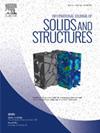Stationary axisymmetric ideal plastic flows in pressure-dependent plasticity
IF 3.4
3区 工程技术
Q1 MECHANICS
International Journal of Solids and Structures
Pub Date : 2025-06-21
DOI:10.1016/j.ijsolstr.2025.113538
引用次数: 0
Abstract
Previous work has developed the ideal flow theory and established that axisymmetric ideal frictionless drawing and extrusion dies can be shaped such that the principal stress trajectories are everywhere coincident with streamlines for Tresca’s solids (i.e., the constitutive equations are Tresca’s yield criterion and its associated flow rule). This design increases these processes’ efficiency and the final product’s strain uniformity. The present work shows that a large class of stationary axisymmetric deformation processes in which the principal stress trajectories are everywhere coincident with streamlines exists for a special case of the double slip and rotation model based on the Mohr-Coulomb yield criterion, extending the ideal flow theory to these constitutive equations. Two equation systems in the form ready for applying the finite-difference method in characteristic space are derived. One of these systems is adopted to calculate the shape of the ideal drawing die for the constitutive equations considered. The effect of the reduction and the internal friction angle on the die’s shape and the drawing stress is illustrated.
静止轴对称理想塑性以压力相关塑性流动
以前的工作已经发展了理想流动理论,并建立了轴对称理想无摩擦拉伸和挤压模具的形状,使得主应力轨迹处处与Tresca固体的流线一致(即,本构方程是Tresca的屈服准则及其相关的流动规则)。该设计提高了这些工艺的效率和最终产品的应变均匀性。本文的工作表明,对于基于Mohr-Coulomb屈服准则的双滑移和旋转模型的特殊情况,存在一类主应力轨迹处处与流线重合的稳态轴对称变形过程,将理想流动理论推广到这些本构方程。导出了两个可以在特征空间中应用有限差分法的方程组。采用其中一个系统对所考虑的本构方程进行了理想拉深模形状的计算。分析了压下量和内摩擦角对模具形状和拉深应力的影响。
本文章由计算机程序翻译,如有差异,请以英文原文为准。
求助全文
约1分钟内获得全文
求助全文
来源期刊
CiteScore
6.70
自引率
8.30%
发文量
405
审稿时长
70 days
期刊介绍:
The International Journal of Solids and Structures has as its objective the publication and dissemination of original research in Mechanics of Solids and Structures as a field of Applied Science and Engineering. It fosters thus the exchange of ideas among workers in different parts of the world and also among workers who emphasize different aspects of the foundations and applications of the field.
Standing as it does at the cross-roads of Materials Science, Life Sciences, Mathematics, Physics and Engineering Design, the Mechanics of Solids and Structures is experiencing considerable growth as a result of recent technological advances. The Journal, by providing an international medium of communication, is encouraging this growth and is encompassing all aspects of the field from the more classical problems of structural analysis to mechanics of solids continually interacting with other media and including fracture, flow, wave propagation, heat transfer, thermal effects in solids, optimum design methods, model analysis, structural topology and numerical techniques. Interest extends to both inorganic and organic solids and structures.

 求助内容:
求助内容: 应助结果提醒方式:
应助结果提醒方式:


